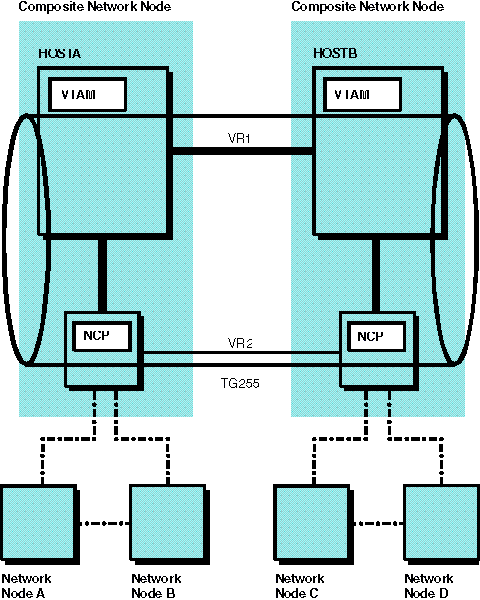 z/OS Communications Server: SNA Network Implementation Guide
z/OS Communications Server: SNA Network Implementation Guide
 z/OS Communications Server: SNA Network Implementation Guide
z/OS Communications Server: SNA Network Implementation Guide
|
Previous topic |
Next topic |
Contents |
Contact z/OS |
Library |
PDF
Virtual-route-based transmission groups z/OS Communications Server: SNA Network Implementation Guide SC27-3672-01 |
|
|
A virtual-route-based transmission group (VR-based TG) connects two APPN-capable VTAM® nodes through a subarea network and allows them to act as APPN peers. The VR-based TG (whose TG number is always 255) then functions as any other TG in an APPN network. APPN CP-CP sessions can be established between these two nodes, which allows all APPN functions to be performed through the subarea network. For example, if the two nodes are attached to disjoint APPN subnetworks, the topologies of these two subnetworks are exchanged over the CP-CP sessions, thereby combining them into one large APPN network. Resource location and session establishment can also be performed through the subarea network using APPN protocols, rather than transforming APPN flows to subarea flows and back to APPN flows. In addition, VR-based TG support can be used in conjunction with HPR support, enabling an HPR route to traverse a VR-based TG. See High-Performance Routing (HPR) for information about HPR support. Only one VR-based TG can be defined between any two VTAM nodes, but this does not limit the use of this TG to only one virtual route (VR). In fact, the VR-based TG is used to represent all possible VRs between any two subareas in the domains of the two VTAMs. For example, in Figure 1, if an application on HOSTA starts a session with an application on HOSTB, the VR-based TG can be selected as the route for this session. When this occurs, VR1 can be assigned as the underlying VR for the session, which will use the channel-to-channel connection between the two hosts. If an independent LU on network node A starts a session with an independent LU on network node D, the VR-based TG can be selected for a portion of the session route. However, in this case, VR2 can be assigned as the underlying VR, so that the direct connection between the two NCPs will be used. Figure 1. VR-based TG between composite
network nodes
 Because an underlying VR is always assigned to sessions established
using VR-based TGs, both APPN and subarea functions must be enabled
on both nodes. This means that each node must be defined as an interchange
node or a migration data host. (That is, the NODETYPE start option
must be coded and each host must define a unique HOSTSA number.)
Also, because a limited number of subarea flows must be sent between
these two nodes to determine which underlying VR should be used, VR-based
TG support also depends on a CDRM session being active between the
two nodes.
Notes:
Figure 2. Multiple contiguous VR-based TGs
 


|
 Copyright IBM Corporation 1990, 2014 Copyright IBM Corporation 1990, 2014 |